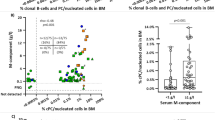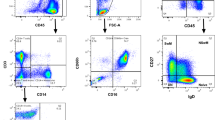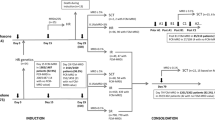Abstract
The surface expression of CD79b, using the monoclonal antibody (Mab) CB3–1, on B lymphocytes from normal individuals and patients with B cell chronic lymphocytic leukemia (CLL) has been analyzed using triple-staining cells for flow cytometry. In addition, the clinical significance of CD79b expression in CLL patients and its possible value for the evaluation of minimal residual disease (MRD) was explored. A total of 15 peripheral blood (PB) samples from healthy blood donors, five bone marrow (BM) samples from normal donors and 40 PB samples from CLL untreated patients were included in the study. In addition we studied the expression of CD79b in B lymphocytes from five CLL patients after fludarabine treatment in order to support our method. The expression of CD79b in B lymphocytes from PB was analyzed by flow cytometry, using simultaneous staining with the Mabs CD22, CD79b, CD19 and CD5, CD79b and CD19. Since normal immature bone marrow B cells are CD79b−/dim+ on their surface, in BM samples we used the combination CD45, CD79b and CD19 selecting mature B lymphocytes according to their bright CD45 intensity. Cell acquisition was performed in two consecutive steps using a live gate drawn on SSC/CD19+ cells. For data analysis, the PAINT-A-GATE PRO software (Becton Dickinson) was used. Dilution experiments of CD79b− CLL cells and CD79bdim+ CLL cells with normal PB and BM cells were performed in order to assess the sensitivity level of the technique for detection of CD79b−/dim+residual CLL cells. All B lymphocytes from normal samples showed reactivity for the CD79b antigen. In contrast, CD79b was absent in 18/40 CLL patients (42.5%) and 20/40 CLL cases (50%) exhibited a low CD79b expression. Therefore, CD79b− B lymphocytes would be restricted to the CLL population and thus could be considered a ‘tumor phenotype’ for monitoring MRD in CLL patients. Dilution experiments indicate that the detection limit with this marker almost reaches the levels obtained by molecular biology methods as the PCR technique. All cases studied after fludarabine presented leukemic cells in their PB or BM samples detected by flow cytometry. Upon comparing the clinical and morphological characteristics of CD79b− and CD79b+ cases, all atypical CLL cases included in the present study were CD79b+ and advanced clinical stage (B and C Binet stage) was most frequently observed in CD79b+ cases than in CD79b− cases.
This is a preview of subscription content, access via your institution
Access options
Subscribe to this journal
Receive 12 print issues and online access
$259.00 per year
only $21.58 per issue
Buy this article
- Purchase on Springer Link
- Instant access to full article PDF
Prices may be subject to local taxes which are calculated during checkout
Similar content being viewed by others
Author information
Authors and Affiliations
Rights and permissions
About this article
Cite this article
Vela, J., Delgado, I., Benito, L. et al. CD79b expression in B cell chronic lymphocytic leukemia: its implication for minimal residual disease detection. Leukemia 13, 1501–1505 (1999). https://doi.org/10.1038/sj.leu.2401511
Received:
Accepted:
Published:
Issue Date:
DOI: https://doi.org/10.1038/sj.leu.2401511
Keywords
This article is cited by
-
Gene signature and immune cell profiling by high-dimensional, single-cell analysis in COVID-19 patients, presenting Low T3 syndrome and coexistent hematological malignancies
Journal of Translational Medicine (2021)
-
Assessing minimal residual disease in chronic lymphocytic leukemia
Current Hematologic Malignancy Reports (2008)
-
Comparative analysis of minimal residual disease detection using four-color flow cytometry, consensus IgH-PCR, and quantitative IgH PCR in CLL after allogeneic and autologous stem cell transplantation
Leukemia (2004)
-
Surface antigen expression in chronic lymphocytic leukemia: clustering analysis, interrelationships and effects of chromosomal abnormalities
Leukemia (2002)
-
Incidence of phenotypic aberrations in a series of 467 patients with B chronic lymphoproliferative disorders: basis for the design of specific four-color stainings to be used for minimal residual disease investigation
Leukemia (2002)



